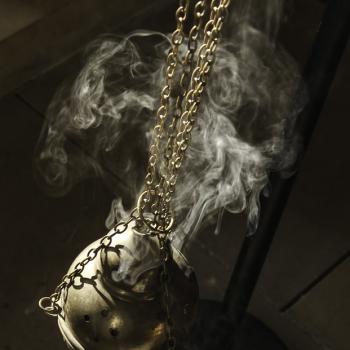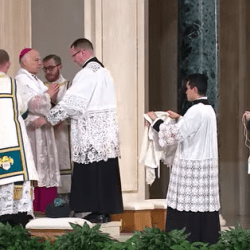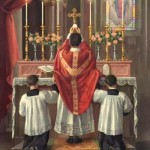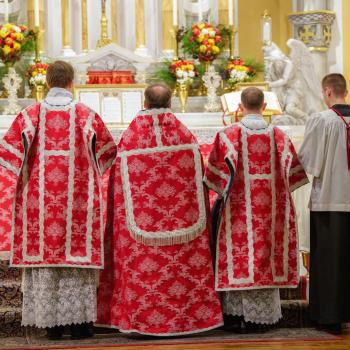A deacon reader asked me if I had a copy of this lying around, and I was able to find this very good version (at the bottom of the page.)
This chant isn’t mandatory and could even be read; unlike The Exsultet, the rubrics don’t even mention the deacon doing it. But this exquisite proclamation can set a beautiful, mystical tone for the Christmas celebration. Some background:
This Proclamation of the Birth of Christ comes from the Roman Martyrology, the official listing of the saints celebrated by the Roman Rite of the Catholic Church. Traditionally, it has been read on Christmas Eve, before the celebration of Midnight Mass. It situates the Nativity of Christ within the context of salvation history, making reference not only to biblical events but also to the Greek and Roman worlds. The coming of Christ at Christmas, then, is seen as the summit of both sacred and secular history.
In the 1980’s, Pope John Paul II restored the Proclamation of the Birth of Christ to the papal celebration of Midnight Mass. (It had been removed during the reform of the liturgy.) Many parishes have followed the Holy Father’s lead.
In my parish, it is chanted by one of our priests with the lights dimmed just before the long entrance processional for Midnight Mass—which, I have to say, is no small thing. The procession includes about 40 altar servers, candles, torches, incense, three priests, the deacon and, bringing up the rear, the pastor carrying the infant Jesus in his arms, all slowly gliding down the aisle to the glorious strains of “Once in Royal David’s City.” Reaching the altar, the pastor places the infant in the manger and the choir segues into “O Come All Ye Faithful,” complete with trumpets. My pastor has described this liturgy as “magical,” and I wouldn’t disagree. More than a few times, I’ve found myself stumbling down the aisle, blinking back tears.
Anyway: a few years ago Jimmy Akin offered a very good dissection of the Christmas Proclamation, noting all the events it mentions and how they situate the birth of Christ. It can help anyone planning to undertake this proclamation understand when and where it all took place.
If you’re going to undertake this beautiful chant, start practicing. And good luck! The text, via the USCCB, below:
The Nativity of our Lord Jesus Christ
The Twenty-fifth Day of December,
when ages beyond number had run their course
from the creation of the world,
when God in the beginning created heaven and earth,
and formed man in his own likeness;
when century upon century had passed
since the Almighty set his bow in the clouds after the Great Flood,
as a sign of covenant and peace;
in the twenty-first century since Abraham, our father in faith,
came out of Ur of the Chaldees;
in the thirteenth century since the People of Israel were led by Moses
in the Exodus from Egypt;
around the thousandth year since David was anointed King;
in the sixty-fifth week of the prophecy of Daniel;
in the one hundred and ninety-fourth Olympiad;
in the year seven hundred and fifty-two
since the foundation of the City of Rome;
in the forty-second year of the reign of Caesar Octavian Augustus,
the whole world being at peace,
JESUS CHRIST, eternal God and Son of the eternal Father,
desiring to consecrate the world by his most loving presence,
was conceived by the Holy Spirit,
and when nine months had passed since his conception,
was born of the Virgin Mary in Bethlehem of Judah,
and was made man:
The Nativity of Our Lord Jesus Christ according to the flesh.












